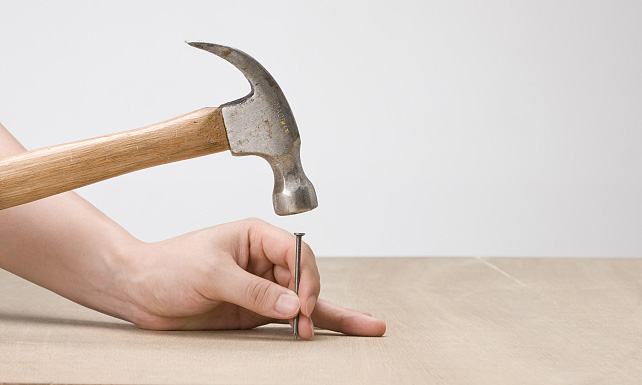Common Nails: The Versatile Workhorse of Basic Building Materials
In the fields of construction, decoration, and various handcrafting projects, common nails are extremely common yet indispensable basic materials. Though seemingly ordinary, they play a crucial role in connection and fixation, just like the cornerstones of a building, silently supporting various structures. This article will delve into all aspects of common nails, providing you with a thorough understanding of this small yet versatile object that appears simple but has a wide range of uses.
I. Definition and Basic Structure of Common Nails
Common nails, namely ordinary iron nails, are pointed fasteners made of metal. They mainly consist of three parts: the nail head, the nail shank, and the nail tip. The nail head is usually relatively wide, which functions to disperse pressure when being hammered, preventing the nail shank from sinking too deeply into the material to be fixed, and also plays a certain role in blocking and fixing. The nail shank is the main part of the common nail, in a cylindrical shape, and its length and diameter vary according to different specifications. The nail tip is sharp, in a rhombic or conical shape, which facilitates easy penetration into various materials to achieve a stable connection.
II. Material Selection and Characteristics
Common nails are mostly made of low-carbon steel, with common grades such as Q195, Q215, and Q235. Low-carbon steel has good plasticity and toughness, which makes common nails easy to process and shape during the manufacturing process, and can withstand a certain degree of bending without breaking when in use. For example, in some scenarios where common nails need to be bent to meet special fixation requirements, low-carbon steel common nails can give full play to their toughness advantages.
In addition, to improve the corrosion resistance of common nails and extend their service life, some common nails undergo surface treatment. Common surface treatment methods include polishing and electroplating. Polished common nails have a smooth and bright surface, which can not only reduce the contact area with air and moisture to a certain extent, lower the risk of rusting, but also enhance their appearance. They are often used in indoor decoration and other occasions that have certain requirements for appearance. Electroplating refers to plating a layer of metal, such as zinc, on the surface of common nails to form a dense protective film, which effectively blocks the erosion of oxygen and moisture on common nails and enhances their rust resistance. Such electroplated common nails perform well in application scenarios such as outdoor construction and humid environments.
III. A Wide Range of Specifications
Common nails come in a wide range of specifications, mainly distinguished by length and diameter. The length ranges from a short 25mm (about 1 inch) to a long 125mm (about 5 inches). Common specifications include 2×25mm, 2.5×50mm, 3.4×65mm, 4×75mm, 4.5×100mm, 4.5×125mm, etc. There are also various diameter options, and different combinations of length and diameter meet the fixation needs of various materials and structures. For light wood connections, thinner and shorter common nails may be used; while in structures such as building frames that need to bear large pressure and tension, thicker and longer common nails will be used.
In practical applications, it is crucial to select common nails of appropriate specifications. If the specification of common nails is too small, they may not provide sufficient fixing force, resulting in unstable connections; if the specification is too large, it may cause unnecessary damage to the material to be fixed and increase the difficulty during the operation process.
IV. Revealing the Manufacturing Process
The manufacturing process of common nails is relatively complex and requires multiple processes. Firstly, high-quality wire rods are selected as raw materials. Wire rods are long strips of steel made by rolling, with high quality and uniform performance. The wire rods are subjected to drawing processing, and their diameter is gradually reduced to the size required for common nail manufacturing through drawing equipment. This process can improve the strength and surface quality of the steel.
Subsequently, the drawn steel wire enters a special nail-making equipment. In the equipment, through a series of molds and stamping processes, the steel wire is processed into common nails with specific shapes and sizes, forming a complete structure of nail head, nail shank, and nail tip. After the manufacturing is completed, quality inspection is also carried out on the common nails, including inspections on dimensional accuracy, surface quality, hardness, etc., to ensure that each common nail meets the corresponding standards and requirements.
V. Wide Application Fields
Due to their versatility and practicality, common nails are widely used in many fields. In the construction industry, common nails are important connectors for building wooden structural frames, such as the roof frames of houses and the installation of wooden doors and windows. In the decoration field, common nails play an important role in the production of indoor wooden furniture, the installation of wooden floors, and the fixation of wall decorative panels. For example, when making a wooden wardrobe, common nails are used to connect various parts of the wardrobe to ensure the stable structure of the wardrobe; when installing wooden floors, common nails fix the wooden floors on the base floor to prevent the floors from shifting.
In the packaging industry, common nails are often used to make wooden boxes, firmly connecting the wooden boards together to protect the safety of the items inside the box during transportation and storage. In some handicraft production and DIY projects, common nails are also commonly used materials, helping enthusiasts realize the production of various creative works, such as the construction of wooden models and the production of small furniture.
VI. Industry Development Trends
With the continuous advancement of science and technology and changes in industry demands, the common nail industry is also developing and innovating continuously. In terms of materials, researchers are constantly exploring new materials or improving existing materials to further enhance the performance of common nails. Some new materials with high strength, corrosion resistance, and environmental protection may be gradually applied to the production of common nails to meet the usage needs in special environments such as marine engineering and chemical construction.
In terms of production technology, the application of automated and intelligent production equipment is becoming more and more widespread. This not only improves production efficiency but also controls the quality and dimensional accuracy of common nails more accurately, reducing production costs. At the same time, to meet the personalized needs of different customers, customized production has also become a trend in the industry's development. Enterprises can produce products that meet specific needs according to customers' requirements on the specifications, surface treatment, and special functions of common nails.
As a basic building material, common nails play an irreplaceable role in various fields with their simple yet practical characteristics. From materials to specifications, from manufacturing processes to applications, they contain rich knowledge and technology. With the development of the industry, common nails are also evolving continuously and will continue to provide solid support for various construction and production projects in the future.



 Send Email
Send Email